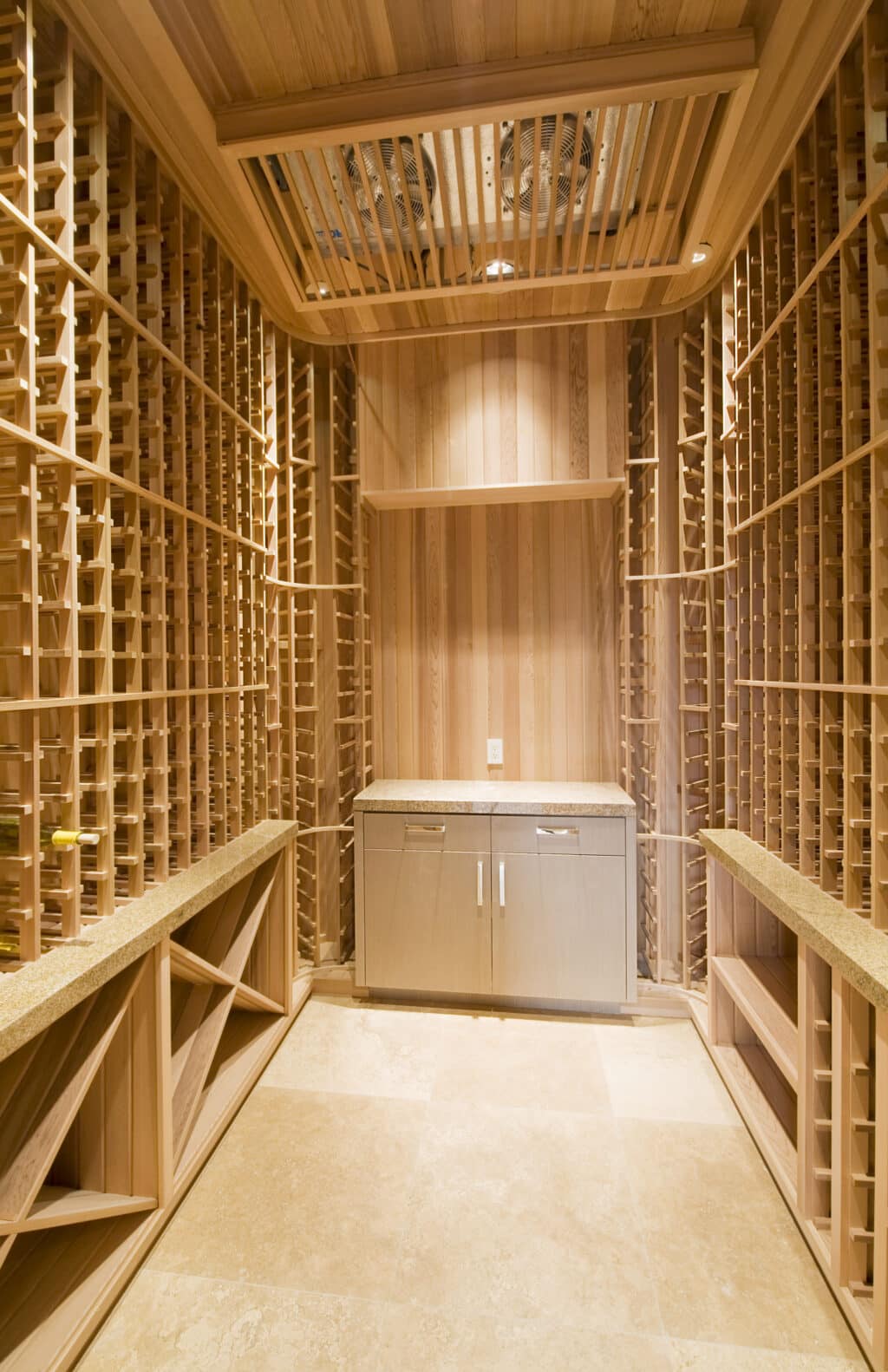
Optimal Cooling Solutions for Wine Storage
Are you aware of how crucial cooling solutions for wine storage are? Proper wine storage is vital for preserving the flavor, aroma, and overall quality of your cherished bottles. Whether you’re a casual wine drinker or a serious collector, maintaining the right environment can make a significant difference.
Wine is sensitive to temperature fluctuations. The optimal storage temperature is generally between 45°F and 65°F, with the ideal being around 55°F. Temperature extremes can spoil wine, leading to changes in color, taste, and aroma. High temperatures can accelerate the aging process, while low temperatures can slow it down too much, or worse, freeze the wine.
In this blog, we’ll explore why cooling solutions are essential for wine storage, the different types available, and factors to consider when choosing a system.

Types of Wine Cooling Solutions
Choosing the right wine cooling solution is crucial for maintaining the quality and longevity of your wine collection. With several options available, understanding the benefits and drawbacks of each type can help you make an informed decision.
Overview of Different Types
- Wine Refrigerators:Description: These are compact, standalone units designed specifically for wine storage.Pros: Easy to install, relatively affordable, and ideal for small collections.Cons: Limited capacity, not suitable for large collections.
- Self-Contained Cooling Units:Description: These are all-in-one systems that cool and circulate air within a wine cellar.Pros: Easy to install, efficient for small to medium-sized cellars, and requires minimal maintenance.Cons: Can be noisy, and may not provide uniform cooling for larger spaces.
- Split Cooling Systems:Description: These systems have a separate evaporator and condenser, allowing for better temperature control.Pros: Quiet operation, customizable installation, ideal for medium to large cellars.Cons: More expensive, requires professional installation.
- Ducted Cooling Systems:Description: These systems use ductwork to distribute cool air evenly throughout the cellar.Pros: Silent operation, even temperature distribution, suitable for large cellars.Cons: Higher installation costs, require significant space for ductwork.
Benefits and Drawbacks of Each Type
- Wine Refrigerators: Perfect for beginners or those with limited space. However, they may not offer the precise temperature control needed for long-term aging.
- Self-Contained Cooling Units: Convenient and efficient but can struggle with larger cellars or in areas with extreme temperatures.
- Split Cooling Systems: Offer superior temperature control and quiet operation, making them ideal for serious collectors. The higher initial cost and need for professional installation can be a barrier.
- Ducted Cooling Systems: Provide the most uniform cooling and silent operation. They are best for large collections but come with higher costs and more complex installation requirements.
Active vs. Passive Cooling Systems
Understanding the differences between active and passive cooling solutions is essential for choosing the right solution for your wine storage needs. Each system offers distinct advantages and disadvantages, making them suitable for different situations.
Differences Between Active and Passive Systems
- Active Cooling Systems:Description: These systems use mechanical devices, such as compressors and fans, to maintain a stable temperature and humidity level within the wine storage area.Features: Precise temperature control, consistent humidity levels, and the ability to cool large areas.Examples: Wine refrigerators, self-contained cooling units, split cooling systems, and ducted cooling systems.
- Passive Cooling Systems:Description: These rely on natural factors, such as the ambient environment and building materials, to regulate temperature and humidity.Features: No mechanical components, often use insulation and thermal mass to maintain stability.Examples: Underground cellars, insulated rooms, and using materials with high thermal mass like stone or concrete.
Ideal Use Cases for Each
- Active Cooling Systems: These are ideal for serious collectors or those who need to store wine in regions with fluctuating temperatures. Active systems are also suitable for large collections where precise control over the storage environment is crucial. For example, a split cooling system or ducted cooling system is perfect for a large, custom-built wine cellar that needs consistent climate control.
- Passive Cooling Systems: These are suitable for those who live in naturally cooler climates or have access to a naturally stable environment, like a basement. Passive systems are often preferred for their lower cost and simplicity. They are ideal for small to medium collections where minor temperature fluctuations will not significantly impact the wine’s aging process.
Advantages and Disadvantages
- Active Cooling Systems:Advantages: Provide precise control over temperature and humidity, suitable for all climates, capable of cooling large areas, and maintaining consistent conditions year-round.Disadvantages: Higher initial cost, ongoing maintenance required, potential for noise from mechanical components, and higher energy consumption.
- Passive Cooling Systems:Advantages: Lower initial cost, minimal maintenance, no noise, and eco-friendly due to lack of mechanical components and energy use.Disadvantages: Dependence on ambient conditions, less precise control over temperature and humidity, and potentially unsuitable for regions with extreme temperature fluctuations.
Self-Contained Cooling Units
When it comes to self-contained cooling units, these systems offer a convenient and effective solution for maintaining the ideal conditions in your wine storage area. Here’s a closer look at what self-contained units are, how they function, and their pros and cons.
Description and Functionality
Self-contained cooling units are all-in-one systems that integrate the evaporator and condenser into a single unit. They are designed to be installed directly within the wine cellar or storage area, where they provide precise temperature and humidity control. These units work by circulating air within the cellar, removing excess heat, and maintaining a stable environment for the wine.
Installation is relatively straightforward compared to more complex systems. These units can be mounted through the wall, ensuring they can vent warm air outside the cellar. The setup generally involves creating an opening in the wall, positioning the unit, and sealing any gaps to ensure optimal efficiency.
Pros and Cons
Pros:
- Ease of Installation: Self-contained units are easier to install than split or ducted systems. They typically require minimal modifications to the existing structure.
- Cost-Effective: These units are often less expensive than more elaborate cooling systems, making them a popular choice for small to medium-sized cellars.
- Compact Design: Their all-in-one design saves space, which is particularly beneficial for smaller storage areas.
- Efficiency: Self-contained units can effectively maintain consistent temperatures and humidity levels, protecting the wine from fluctuations that can cause damage.
Cons:
- Noise Levels: One of the primary drawbacks of self-contained units is the noise they produce. Since both the evaporator and condenser are in one unit, they can be louder compared to split systems where the noisy components are placed outside the storage area.
- Limited Capacity: These units are best suited for small to medium-sized cellars. They may not be powerful enough to cool larger areas effectively.
- Heat Dissipation: Because these units need to vent warm air, they must be placed in a location where this is possible. Improper installation can lead to inefficient cooling and higher energy consumption.
Ideal Use Cases
Self-contained cooling units are ideal for home wine cellars and small commercial storage spaces where ease of installation and cost are major considerations. They are perfect for enthusiasts who have collections ranging from a few dozen to a few hundred bottles and require reliable climate control without the complexity of more advanced systems.

Split Cooling Systems
Split cooling systems are an excellent option for those seeking more advanced and customizable cooling solutions for their wine storage. These systems offer precise control over the storage environment, making them ideal for larger collections and more serious collectors.
How Split Systems Work
A split cooling solution consists of two main components: the evaporator and the condenser. These components are separated and connected by refrigerant lines. The evaporator is installed inside the wine cellar, while the condenser is placed outside the storage area, often in an adjacent room or even outdoors.
- Evaporator: This unit is responsible for cooling the air within the wine cellar. It absorbs heat from the air and circulates cool air back into the storage area.
- Condenser: Located outside the cellar, the condenser dissipates the heat absorbed by the evaporator. This separation helps minimize noise and vibration within the storage space, providing a quieter environment.
Advantages and Disadvantages of Split Cooling Solutions
Advantages of Cooling Solutions
- Quiet Operation: Since the condenser is located outside the cellar, split systems operate quietly, making them suitable for installation in living areas or spaces where noise is a concern.
- Effective Cooling: These systems provide excellent temperature and humidity control, ensuring optimal conditions for wine storage.
- Customizable: Split systems can be tailored to fit various sizes and configurations of wine cellars, offering flexibility in installation.
- Reduced Heat Load: By placing the condenser outside the cellar, split systems reduce the heat load within the storage area, improving efficiency and effectiveness.
Disadvantages of Cooling Solutions
- Higher Cost: Split systems tend to be more expensive than self-contained units, both in terms of initial purchase and installation.
- Complex Installation: Professional installation is typically required to ensure the refrigerant lines are correctly connected and the system is properly calibrated. This can increase the overall cost and time needed to set up the system.
- Maintenance: Regular maintenance is essential to keep split systems running efficiently. This includes checking refrigerant levels, cleaning components, and ensuring the system is free from leaks or obstructions.
Ideal Use Cases
Split cooling systems are ideal for medium to large wine cellars and for collectors who require precise environmental control.
They are particularly suitable for serious collectors or commercial wine storage facilities where maintaining the perfect conditions is crucial. Additionally, split systems are beneficial in situations where noise reduction is important, such as in residential areas.
Ducted Cooling Systems
Ducted cooling systems represent the pinnacle of wine storage technology, offering seamless integration and exceptional performance. These systems are designed to provide uniform cooling and humidity control across large storage areas, making them a preferred choice for serious collectors and commercial wine cellars.
Explanation of Ducted Systems
Ducted cooling systems consist of a central cooling unit connected to a network of ducts that distribute conditioned air throughout the wine cellar.
The central unit, typically installed outside the cellar, cools the air, which is then funneled through ducts and vents strategically placed within the storage area. This setup ensures that every corner of the cellar maintains consistent temperature and humidity levels.
- Central Unit: The heart of the system, responsible for cooling and dehumidifying the air.
- Ductwork: A network of insulated ducts that carry the conditioned air to various parts of the wine cellar.
- Vents and Registers: Openings in the ducts that release the cool air into the storage area, ensuring even distribution.
Benefits and Challenges of Ducted Cooling Solutions
Benefits of Cooling Solutions
- Uniform Temperature Control: Ducted systems provide even cooling throughout the cellar, preventing hotspots and ensuring all bottles are stored at the same optimal conditions.
- Quiet Operation: Since the central cooling unit is located outside the storage area, ducted systems operate silently, enhancing the ambiance of your wine cellar.
- Aesthetic Flexibility: The ductwork can be hidden behind walls or ceilings, preserving the aesthetic appeal of your cellar without visible cooling units.
- Scalability: Ducted systems are suitable for large wine cellars and can be scaled to meet the needs of extensive collections.
Challenges of using Cooling Solutions
- High Initial Cost: Ducted systems are among the most expensive cooling solutions, both in terms of equipment and installation.
- Complex Installation: Professional installation is required to design and install the ductwork, which can be time-consuming and costly.
- Space Requirements: Adequate space is needed for the central unit and ductwork, which may not be feasible in all locations.
- Maintenance: Regular maintenance is necessary to ensure the system operates efficiently, including cleaning ducts and checking for leaks.
Ideal Use Cases for Ducted Cooling Solutions
Ducted cooling systems are ideal for large wine cellars and commercial facilities where maintaining a consistent environment is critical.
They are perfect for collectors who prioritize aesthetics and want a discreet cooling solution that doesn’t interfere with the design of their cellar. Additionally, ducted systems are well-suited for environments where silent operation is a priority, such as residential settings or high-end restaurants.
Choosing a ducted cooling system means investing in the best possible solution for large-scale, high-quality wine storage. These systems provide the ultimate in performance, aesthetics, and environmental control, ensuring your wine collection is preserved under the best possible conditions.
Case Study: Cooling Solutions in Addison, TX
Overview of Local Climate Challenges
Addison, TX, experiences a hot and humid climate, which can pose significant challenges for wine storage. Summers in Addison are characterized by high temperatures that often exceed 90°F, coupled with humidity levels that can reach uncomfortable highs. These conditions are far from ideal for wine storage, as heat and humidity can adversely affect wine quality.
Temperature Fluctuations: The drastic changes between hot summers and cooler winters can create a fluctuating environment. These fluctuations can cause the wine to expand and contract, potentially compromising the cork’s integrity and allowing air to seep in, which can spoil the wine.
Humidity Levels: High humidity levels can lead to mold growth, which can damage wine labels and even the corks themselves. Low humidity, on the other hand, can dry out corks, leading to oxidation and spoilage. Maintaining a stable humidity level is crucial to preserving the quality of the wine.
Popular Solutions Among Addison Residents
Residents of Addison have adopted various cooling solutions to combat the local climate challenges and ensure their wine collections remain in optimal condition.
- Self-Contained Cooling Units:Popularity: These units are favored for their ease of installation and cost-effectiveness. Many Addison residents with small to medium-sized collections find self-contained units to be an ideal solution.Effectiveness: They provide reliable temperature and humidity control, which is essential in the hot and humid climate of Addison. However, their capacity limitations make them less suitable for larger collections.
- Split Cooling Systems:Popularity: Split systems are increasingly popular among serious collectors and those with larger cellars. The ability to place the condenser unit outside the living area reduces noise and improves cooling efficiency.Effectiveness: These systems offer precise control over the storage environment, making them well-suited to Addison’s climate. The professional installation ensures that the system is optimized for the specific conditions of the cellar.
- Ducted Cooling Systems:Popularity: While more expensive, ducted systems are chosen by those who want the best possible cooling solution. These systems are ideal for large, custom-built cellars where aesthetics and silent operation are a priority. Effectiveness: Ducted systems provide uniform temperature and humidity control, essential for preserving wine in Addison’s fluctuating climate. Their ability to maintain consistent conditions throughout the cellar makes them the top choice for serious collectors.
FAQs About Wine Cooling Solutions
-
What is the ideal temperature for storing wine?
The ideal temperature for storing wine is around 55°F. Keeping your wine at this consistent temperature helps maintain its quality and flavor over time.
-
Can I use a regular refrigerator to store wine?
Regular refrigerators are not ideal for wine storage. They are too cold and can dry out the cork, leading to oxidation. Wine coolers or specialized wine storage units are better options.
-
How does humidity affect wine storage?
Proper humidity levels, typically between 50-70%, are crucial for wine storage. High humidity can cause mold growth, while low humidity can dry out the cork, both of which can spoil the wine.
-
What are the benefits of a split cooling system over a self-contained unit?
Split cooling systems offer quieter operation and better cooling efficiency. They are ideal for larger cellars and serious collectors. Self-contained units are easier to install and more affordable, making them suitable for smaller collections.
-
How often should I maintain my wine cooling system?
Regular maintenance is essential for optimal performance. Check and clean filters every few months, inspect for any leaks or malfunctions, and schedule professional maintenance annually to ensure the system runs efficiently.
Choosing the right cooling solution for wine storage is essential to preserving the quality and longevity of your wine collection. Whether you opt for a self-contained unit, a split system, or a ducted system, understanding your needs and the local climate challenges, such as those in Addison, TX, can help you make an informed decision.







